Measurement of Personal Experienced Temperature Variations in Rural Households Using Wearable Monitors: A Pilot Study
Abstract
1. Introduction
2. Methods and Materials
2.1. Research Site and Subjects
2.2. Field Study Methods
2.2.1. Continuous Field Test
2.2.2. Questionnaire Surveys
- Part A: Personal basic information and living habits in winter.In addition to the basic information of the volunteers listed in the Table 1 the ID number of the device given to each volunteer and the volunteers’ living habits in winter were recorded. Among the living habit questions related to adjusting clothing or altering the environment were listed in Table A1 of Appendix A.
- Part B: Personal thermal exposure experience.In the second part, we expected to gather information on personal thermal exposure experience during the monitoring period, while ensuring that the temperature data subsequently used for analysis was a valid record of the volunteer’s experienced temperature. For example, if a volunteer was outdoors but left the monitoring device indoors, temperature data recorded while the volunteer was not wearing the device as required would be eliminated prior to formal analysis. The volunteers had to respond to three questions regarding their habits while outside and four more questions primarily related to comfort and compliance of the monitoring devices (see Table A2 of Appendix A).
- Part C: General thermal comfort of experienced thermal environments.Along with obtaining test data on the volunteers’ experienced temperature, understanding their general thermal comfort with the thermal environment they experienced was one of the intended goals of the methods presented in this study. However, since the measurement did not cover all six parameters affecting thermal sensation, thermal comfort could not be analytical determined and interpreted directly according to the ISO 7730 [18] by calculating the PMV (predicted mean vote) and PPD (predicted percentage of dissatisfied) indices. It is well known that the use of subjective scales is an important tool for assessing thermal comfort of the physical environments. International standards ISO 10551 [50] and ISO 28802 [29] provide a number of subjective scales for thermal environment survey. However, the scales of these standards are mainly applicable to the point-in-time surveys and can only reflect the thermal sensation and comfort at the moment of survey. Therefore, it is clear from Table A3 of Appendix A that this study incorporated questions from both standards (e.g., questions C-5 and C-6 from ISO 10551, and question C-7 from ISO 28802) that were applicable to general thermal comfort surveys and developed four other questions following the principles of ISO 10551 to assess volunteers’ responses to the environment during the monitoring.
2.3. Time Period of the Field Investigation
2.4. Data Analysis
2.4.1. Data Processing and Data Analysis
2.4.2. Reference Scenarios for Analyses
3. Results
3.1. Survey Results on Living Habits in Winter and the Thermal Environment Experiences
3.1.1. Personal Living Habits in Winter
3.1.2. Personal Thermal Exposure Experience
3.2. Overview of Outdoor air Temperature and Personal Experienced Temperatures
- Volunteers had different and individualized personal temperature experiences.
- Temperature changes during daytime are distinct from those at night.
3.3. Personal Experienced Temperature Ranges and Distribution
3.4. Differences in Personal Experienced Temperatures
4. Discussion
4.1. Continuous Field Test
4.2. Questionnaire Survey
4.3. Data Analysis and Interpretation
5. Conclusions
- The personal experienced temperatures gathered during the two-day period exhibit wide ranges and large variations. Meanwhile, the highest and lowest temperatures experienced by the residents reached 30.6 and −16.6 °C, respectively.
- The residents had very similar or identical living habits in winter and coping strategies for thermal discomfort, as well as same general thermal comfort evaluation results for experienced thermal environment during the study period. However, there were some obvious differences in the personal temperatures experienced by different households from the same village, and even between different residents from the same household. This suggests that similar or identical living habits, coupled with same general thermal comfort level cannot infer that residents are at the same level of thermal environment.
- As far as methodology is concerned, this study indicates that using personal wearable monitors is a viable method to measure the temperature experienced by an individual. It not only extended the method of collecting data regarding complex experiences in different environments, but also could help in the study of human responses to the real-world thermal environment.
Author Contributions
Funding
Acknowledgments
Conflicts of Interest
Appendix A
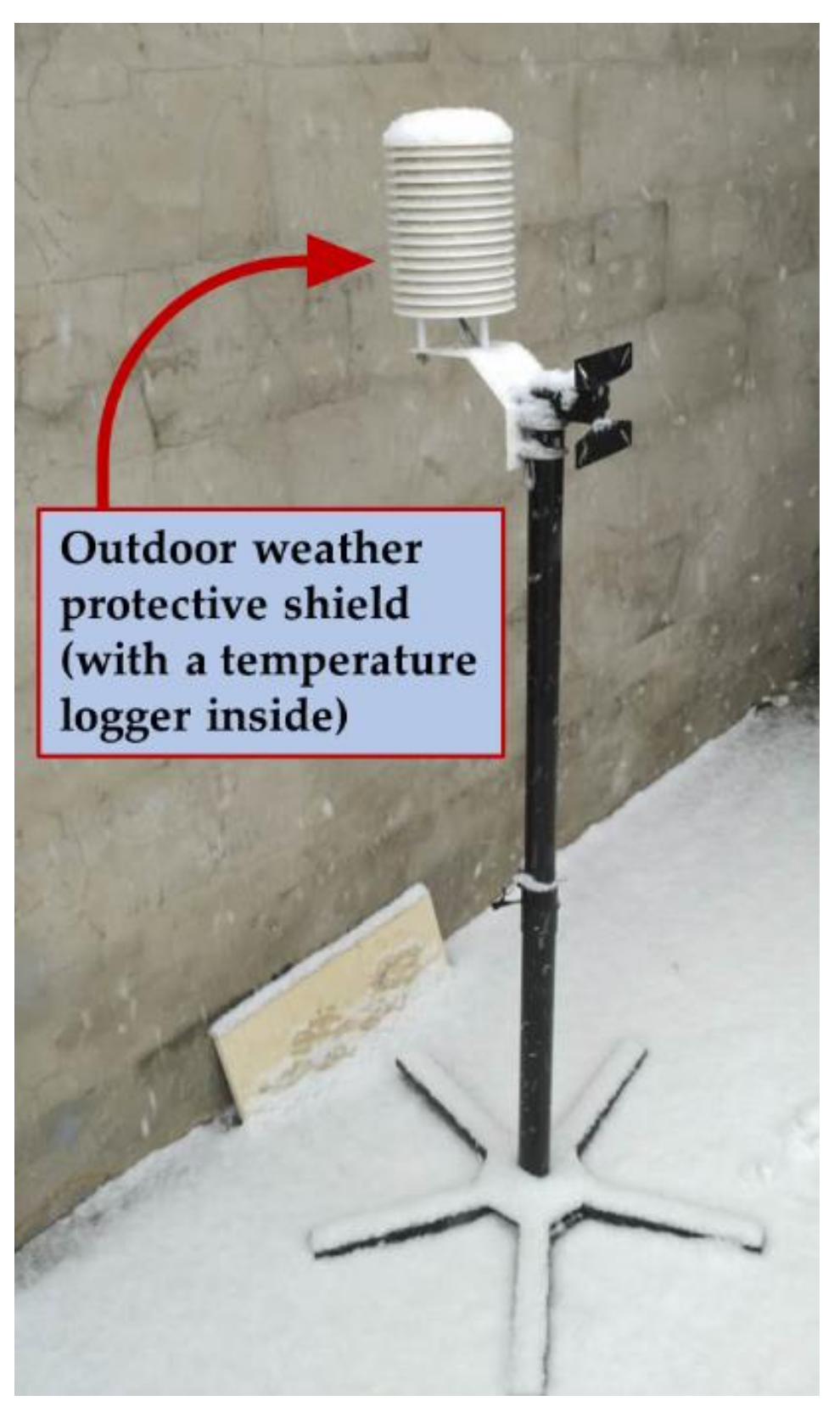
| Questions | Answers |
|---|---|
| A-1 “Do you have the habit of changing shoes when you go indoors and outdoors?” | -Yes -No |
| A-2 “Do you have the habit of changing clothes when you go indoors and outdoors?” | -Yes -No |
| A-3 “If you feel hot in a room, what measures do you often use to ease (you may select more than one)?” | -Opening windows or doors -Putting on fewer clothes -Drinking cold drinks -Reducing movements -Reducing indoor heating supply -Going to a cooler room -Other, please specify |
| A-4 “If you feel cold in a room, what measures do you often use to ease (you may select more than one)?” | -Closing windows and doors -Putting on more clothes -Drinking hot drinks -Increasing movements -Increasing indoor heating supply -Going to a warmer room -Other, please specify |
| Questions | Answers |
|---|---|
| B-1 “Have you ever been to the outside since wearing the device or since our last visit?” | -Yes -No |
| B-2 “Have you changed your shoes when you go indoors and outdoors since wearing the device or since our last visit?” | -Yes, please specify -No |
| B-3 “Have you changed your clothes when you go indoors and outdoors since wearing the device or since our last visit?” | -Yes, please specify -No |
| B-4 “Do you have any trouble or feeling uncomfortable by wearing the device?” | -Yes, please specify -No |
| B-5 “Does wearing the device affect your normal movements or lifestyle?” | -Yes, please specify -No |
| B-6 “Have you deliberately changed your behavior because of wearing the device?” | -Yes, please specify -No |
| B-7 “According to your records, please indicate the (period of) time when you did not wear the device since the first time you put it on or since our last visit (you may select more than one option)?” | -Bedtime at night -Naptime in the afternoon -Other, please specify |
| Questions | Answers |
|---|---|
| C-1 “Have you ever felt uncomfortable with the air temperature since wearing the device or since our last visit?” | -Yes, please specify -No |
| C-2 “Have you experienced any unacceptable air temperature since wearing the device or since our last visit?” | -Yes, please specify -No |
| C-3 “Have you ever felt uncomfortable with the general thermal environment since wearing the device or since our last visit?” | -Yes, please specify -No |
| C-4 “Have you experienced any unacceptable thermal environment since wearing the device or since our last visit?” | -Yes, please specify -No |
| C-5 “In your opinion the thermal environment you have experienced since wearing the device or since our last visit is tolerable?” | -Yes -No |
| C-6 “Taking into account your personal preference only, would you accept rather than reject the thermal environment you have experienced since wearing the device or since our last visit?” | -Yes -No |
| C-7 “Are you generally satisfied with thermal environment you have experienced since wearing the device or since our last visit?” | -Yes -No |

References
- Chen, H.; Chen, W. Potential impact of shifting coal to gas and electricity for building sectors in 28 major northern cities of China. Appl. Energy 2019, 236, 1049–1061. [Google Scholar] [CrossRef]
- THUBERC. 2020 Annual Report on China Building Energy Efficiency; China Architecture & Building Press: Beijing, China, 2020. [Google Scholar]
- Ma, R.; Mao, C.; Shan, M.; Zhang, L.; Yang, X. Occupant control patterns of low temperature air-to-air heat pumps in Chinese rural households based on field measurements. Energy Build. 2017, 154, 157–165. [Google Scholar] [CrossRef]
- Ma, R.; Mao, C.; Ding, X.; Deng, M.; Baumgartner, J.; Wang, X.; Wang, X.; Yang, W.; Liu, H.; Shan, M.; et al. Diverse heating demands of a household based on occupant control behavior of individual heating equipment. Energy Build. 2020, 207, 109612. [Google Scholar] [CrossRef]
- Huang, L.; Zhu, Y.; Ouyang, Q.; Cao, B. Field survey of indoor thermal comfort in rural housing of northern China in heating season. J. Southeast Univ. (English Ed.) 2010, 26, 169–172. [Google Scholar]
- Zhu, Y.; Liu, J. Research on the indoor thermal environment of rural architecture in winter in northwestern areas. China Civ. Eng. J. 2010, 43, 399–403. [Google Scholar]
- Wang, Z.J.; Sheng, X.; Ren, J.; Ji, Y. Field survey on indoor thermal comfort in rural houses around Harbin in winter. HV&AC 2014, 44, 71–75. [Google Scholar]
- Zhang, N.; Cao, B.; Wang, Z.; Zhu, Y.; Lin, B. A comparison of winter indoor thermal environment and thermal comfort between regions in Europe, North America, and Asia. Build. Environ. 2017, 117, 208–217. [Google Scholar] [CrossRef]
- Cao, B.; Luo, M.; Li, M.; Zhu, Y. Too cold or too warm? A winter thermal comfort study in different climate zones in China. Energy Build. 2016, 133, 469–477. [Google Scholar] [CrossRef]
- Yan, H.; Yang, L.; Zheng, W.; Li, D. Influence of outdoor temperature on the indoor environment and thermal adaptation in Chinese residential buildings during the heating season. Energy Build. 2016, 116, 133–140. [Google Scholar] [CrossRef]
- Wang, Z.; Ji, Y.; Su, X. Influence of outdoor and indoor microclimate on human thermal adaptation in winter in the severe cold area, China. Build. Environ. 2018, 133, 91–102. [Google Scholar] [CrossRef]
- THUBERC. 2012 Annual Report on China Building Energy Efficiency; China Architecture & Building Press: Beijing, China, 2012. [Google Scholar]
- Shao, N.; Ma, L.; Zhang, J. Study on the rural residence heating temperature based on the residents behavior pattern in South Liaoning province. Energy Build. 2018, 174, 179–189. [Google Scholar] [CrossRef]
- Fanger, P.O. Thermal Comfort: Analysis and Applications in Environmental Engineering; Danish Technical Press: Copenhagen, Denmark, 1970. [Google Scholar]
- Dear, R.J.d.; Akimoto, T.; Arens, E.A.; Brager, G.; Candido, C.; Cheong, K.W.D.; Li, B.; Nishihara, N.; Sekhar, S.C.; Tanabe, S.; et al. Progress in thermal comfort research over the last twenty years. Indoor Air 2013, 23, 442–461. [Google Scholar] [CrossRef] [PubMed]
- Van Hoof, J. Forty years of Fanger’s model of thermal comfort: comfort for all? Indoor Air 2008, 18, 182–201. [Google Scholar] [CrossRef]
- Djongyang, N.; Tchinda, R.; Njomo, D. Thermal comfort: A review paper. Renew. Sustain. Energy Rev. 2010, 14, 2626–2640. [Google Scholar] [CrossRef]
- ISO. ISO 7730:2005 Ergonomics of the Thermal Environment—Analytical Determination and Interpretation of Thermal Comfort Using Calculation of the PMV and PPD Indices and Local Thermal Comfort Criteria; International Organization for Standardization: Geneva, Switzerland, 2005. [Google Scholar]
- Olesen, B.W.; Brager, G.S. A better way to predict comfort: the new ASHRAE standard 55-2004. ASHRAE J. 2004, 46, 20–26. [Google Scholar]
- ASHRAE. ANSI/ASHRAE Standard 55-2004 Thermal Environmental Conditions for Human Occupancy; American Society of Heating, Refrigerating and Air-Conditioning Engineers: Atlanta, GA, USA, 2004. [Google Scholar]
- Olesen, B.W.; Parsons, K.C. Introduction to thermal comfort standards and to the proposed new version of EN ISO 7730. Energy Build. 2002, 34, 537–548. [Google Scholar] [CrossRef]
- Kuras, E.R.; Richardson, M.B.; Calkins, M.M.; Ebi, K.L.; Hess, J.J.; Kintziger, K.W.; Jagger, M.A.; Middel, A.; Scott, A.A.; Spector, J.T.; et al. Opportunities and Challenges for Personal Heat Exposure Research. Environ. Health Perspect. 2017, 125, 085001. [Google Scholar] [CrossRef]
- Forgiarini, R.; Giraldo, N.; Lamberts, R. A review of human thermal comfort in the built environment. Energy Build. 2015, 105, 178–205. [Google Scholar]
- Chun, C.; Kwok, A.; Mitamura, T.; Miwa, N.; Tamura, A. Thermal diary: Connecting temperature history to indoor comfort. Build. Environ. 2008, 43, 877–885. [Google Scholar] [CrossRef]
- Li, W.; Zhang, J.; Wang, J.; Liang, R. Experimental study of human thermal sensation estimation model in built environment based on the Takagi—Sugeno fuzzy model. Build. Simul. 2019, 12, 365–377. [Google Scholar] [CrossRef]
- Lai, D.; Guo, D.; Hou, Y.; Lin, C.; Chen, Q. Studies of outdoor thermal comfort in northern China. Build. Environ. 2014, 77, 110–118. [Google Scholar] [CrossRef]
- Ning, H.; Wang, Z.; Ji, Y. Thermal history and adaptation: Does a long-term indoor thermal exposure impact human thermal adaptability ? Appl. Energy 2016, 183, 22–30. [Google Scholar] [CrossRef]
- Cao, B.; Zhu, Y.; Li, M.; Ouyang, Q. Individual and district heating: A comparison of residential heating modes with an analysis of adaptive thermal comfort. Energy Build. 2014, 78, 17–24. [Google Scholar] [CrossRef]
- ISO. ISO 28802:2012 Ergonomics of the Physical EnvironmentȔAssessment of Environments by Means of an Environmental Survey Involving Physical Measu Rements of the Environment and Subjective Responses of People; International Organization for Standardization: Geneva, Switzerland, 2012. [Google Scholar]
- Steinle, S.; Reis, S.; Sabel, C.E.; Semple, S.; Twigg, M.M.; Braban, C.F.; Leeson, S.R.; Heal, M.R.; Harrison, D.; Lin, C.; et al. Personal exposure monitoring of PM 2.5 in indoor and outdoor microenvironments. Sci. Total Environ. 2015, 508, 383–394. [Google Scholar] [CrossRef] [PubMed]
- Brani, M.; Kolomazníková, J. Monitoring of long-term personal exposure to fine particulate matter (PM2.5). Air Qual. Atmos. Heal. 2010, 3, 235–243. [Google Scholar] [CrossRef]
- Chen, X.-C.; Chow, J.C.; Ward, T.J.; Cao, J.-J.; Lee, S.-C.; Watson, J.G.; Lau, N.-C.; Yim, S.H.L.; Ho, K.-F. Estimation of personal exposure to fi ne particles (PM 2.5) of ambient origin for healthy adults in Hong Kong. Sci. Total Environ. 2019, 654, 514–524. [Google Scholar] [CrossRef]
- Jacklitsch, B.; Williams, W.J.; Musolin, K.; Coca, A.; Kim, J.-H.; Turner, N. NIOSH criteria for a Recommended Standard: Occupational Exposure to Heat and Hot Environments; DHHS (NIOSH) Publication No. 2016-106, 2016. Available online: https://www.cdc.gov/niosh/docs/2016-106/pdfs/2016-106.pdf (accessed on 16 September 2020).
- JSOH Recommendation of Occupational Exposure Limits. J. Occup. Health 2018, 60, 419–452. [CrossRef]
- Oliveira, A.V.M.; Gaspar, A.R.; Quintela, D.A. Occupational exposure to cold thermal environments: A field study in Portugal. Eur. J. Appl. Physiol. 2008, 104, 207–214. [Google Scholar] [CrossRef]
- Hoehne, C.G.; Hondula, D.M.; Chester, M.V.; Eisenman, D.P.; Middel, A.; Fraser, A.M.; Watkins, L.; Gerster, K. Heat exposure during outdoor activities in the US varies significantly by city, demography, and activity. Health Place 2018, 54, 1–10. [Google Scholar] [CrossRef]
- Bernhard, M.C.; Kent, S.T.; Sloan, M.E.; Evans, M.B.; Mcclure, L.A.; Gohlke, J.M. Measuring personal heat exposure in an urban and rural environment. Environ. Res. 2015, 137, 410–418. [Google Scholar] [CrossRef]
- Shan, M.; Wang, P.; Li, J.; Yue, G.; Yang, X. Energy and environment in Chinese rural buildings: Situations, challenges, and intervention strategies. Build. Environ. 2015, 91, 271–282. [Google Scholar] [CrossRef]
- Yang, X.; Jiang, Y.; Yang, M.; Shan, M. Energy and environment in Chinese rural housing : Current status and future perspective. Front. Energy Power Eng. China 2010, 4, 35–46. [Google Scholar] [CrossRef]
- Xu, J.; Gao, W.; Huo, X. Analysis on energy consumption of rural building based on survey in northern China. Energy Sustain. Dev. 2018, 47, 34–38. [Google Scholar]
- Evans, M.; Yu, S.; Song, B.; Deng, Q.; Liu, J.; Delgado, A. Building energy efficiency in rural China. Energy Policy 2014, 64, 243–251. [Google Scholar] [CrossRef]
- Basu, R.; Samet, J.M. An Exposure Assessment Study of Ambient Heat Exposure in an Elderly Population in Baltimore, Maryland. Environ. Health Perspect. 2002, 110, 1219–1224. [Google Scholar] [CrossRef]
- Kuras, E.R.; Hondula, D.M.; Brown-Saracino, J. Heterogeneity in individually experienced temperatures (IETs) within an urban neighborhood: insights from a new approach to measuring heat exposure. Int. J. Biometeorol. 2015, 59, 1363–1372. [Google Scholar] [CrossRef]
- Jagger, M.A.; Kintziger, K.W. Where to Wear iButtons: Individual Level Temperature and Humidity Observations for Public Health Surveillance. In Proceedings of the American Meteorological Society Annual Meeting, New Orleans, LA, USA, 10–14 January 2016. [Google Scholar]
- Gunga, H.-C. Human Physiology in Extreme Environments; Academic Press: Boston, MA, USA, 2015. [Google Scholar]
- ISO. ISO 7726:1998 Ergonomics of the Thermal Environment—Instruments for Measuring Physical Quantities; International Organization for Standardization: Geneva, Switzerland, 1998. [Google Scholar]
- Weihs, P.; Schmalwieser, A.; Reinisch, C.; Meraner, E.; Walisch, S.; Harald, M. Measurements of Personal UV Exposure on Different Parts of the Body During Various Activities. Photochem. Photobiol. 2013, 89, 1004–1007. [Google Scholar] [CrossRef]
- Liu, S.; Schiavon, S.; Das, H.P.; Jin, M.; Spanos, C.J. Personal thermal comfort models with wearable sensors. Build. Environ. 2019, 162, 106281. [Google Scholar] [CrossRef]
- Ji, W.; Cao, B.; Geng, Y.; Zhu, Y.; Lin, B. A study on the influences of immediate thermal history on current thermal sensation. Energy Build. 2019, 198, 364–376. [Google Scholar] [CrossRef]
- ISO. ISO 10551:2019 Ergonomics of the Physical Environment—Subjective Judgement Scales for Assessing Physical Environments; International Organization for Standardization: Geneva, Switzerland, 2019. [Google Scholar]
- Ma, S.; Zhu, C. Extreme Cold Wave over East Asia in January 2016 : A Possible Response to the Larger Internal Atmospheric Variability Induced by Arctic Warming. J. Clim. 2019, 32, 1203–1216. [Google Scholar] [CrossRef]
- ASHRAE ANSI/ASHRAE Standard 55-2017 Thermal Environmental Conditions for Human Occupancy; American Society of Heating, Refrigerating and Air-Conditioning Engineers: Atlanta, GA, USA, 2017.
- MOHURD. GB 50736-2012 Design Code for Heating Ventilation and Air Conditioning of Civil Buildings; China Architecture & Building Press: Beijing, China, 2012. [Google Scholar]
- CECS. CECS 332:2012 Design Standard for Energy-efficient of Detached Rural Housing; China Planning Press: Beijing, China, 2012. [Google Scholar]
- Wang, C.; Yan, D.; Jiang, Y. A novel approach for building occupancy simulation. Build. Simul. 2011, 4, 149–167. [Google Scholar] [CrossRef]
- Li, M. Quantitative clothing insulation for thermal comfort in China. Master’s Thesis, Tsinghua University, Beijing, China, 2015. [Google Scholar]
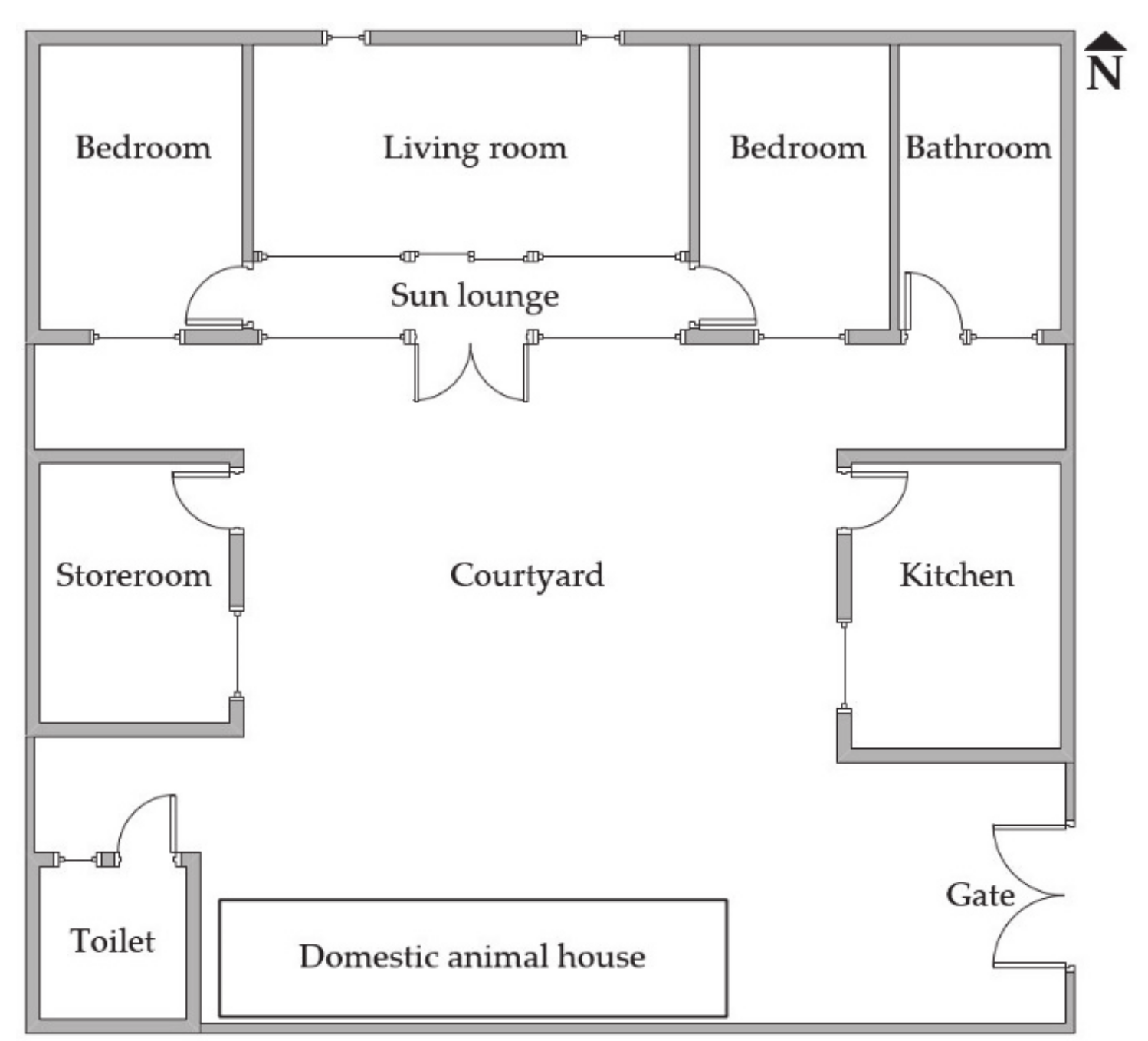
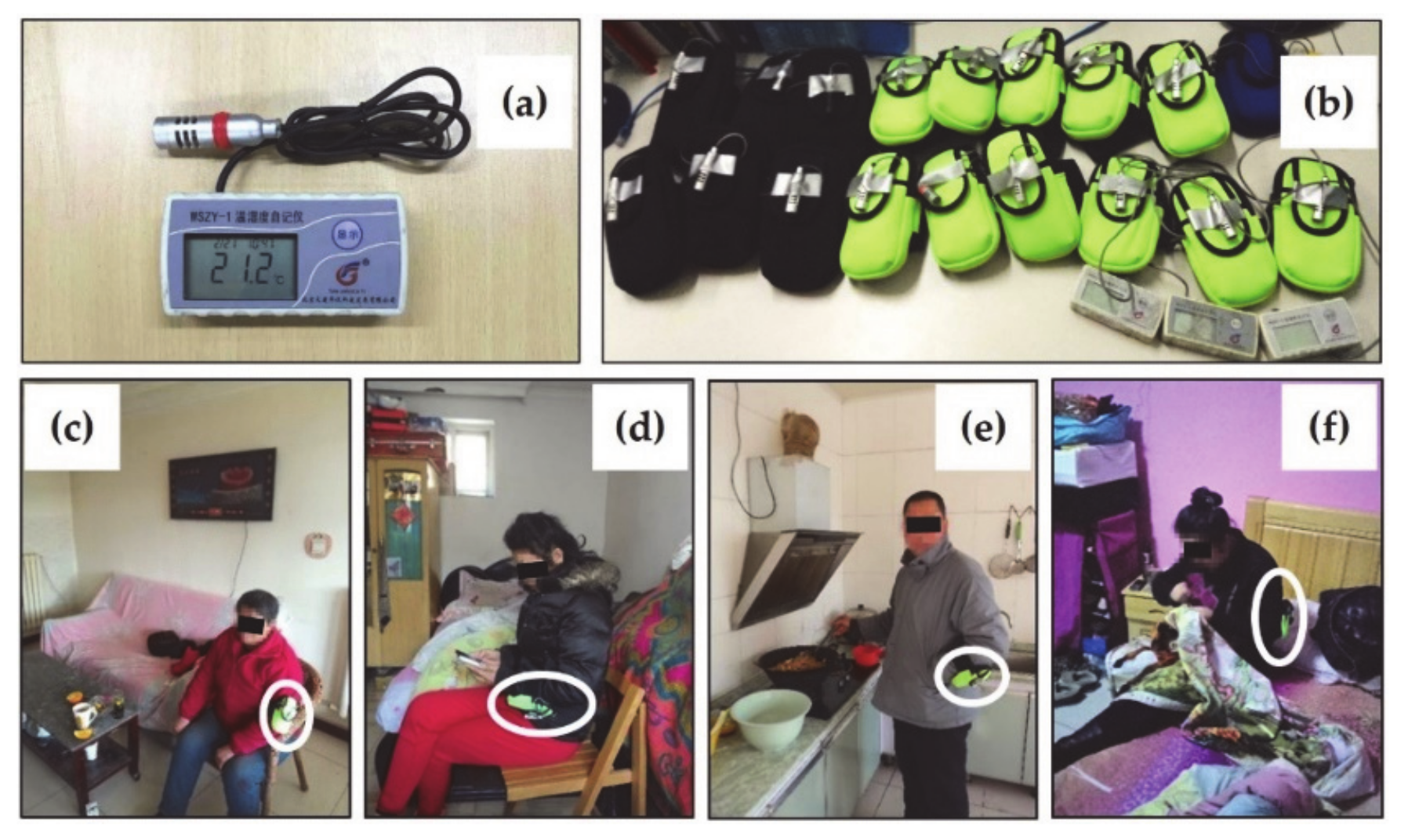
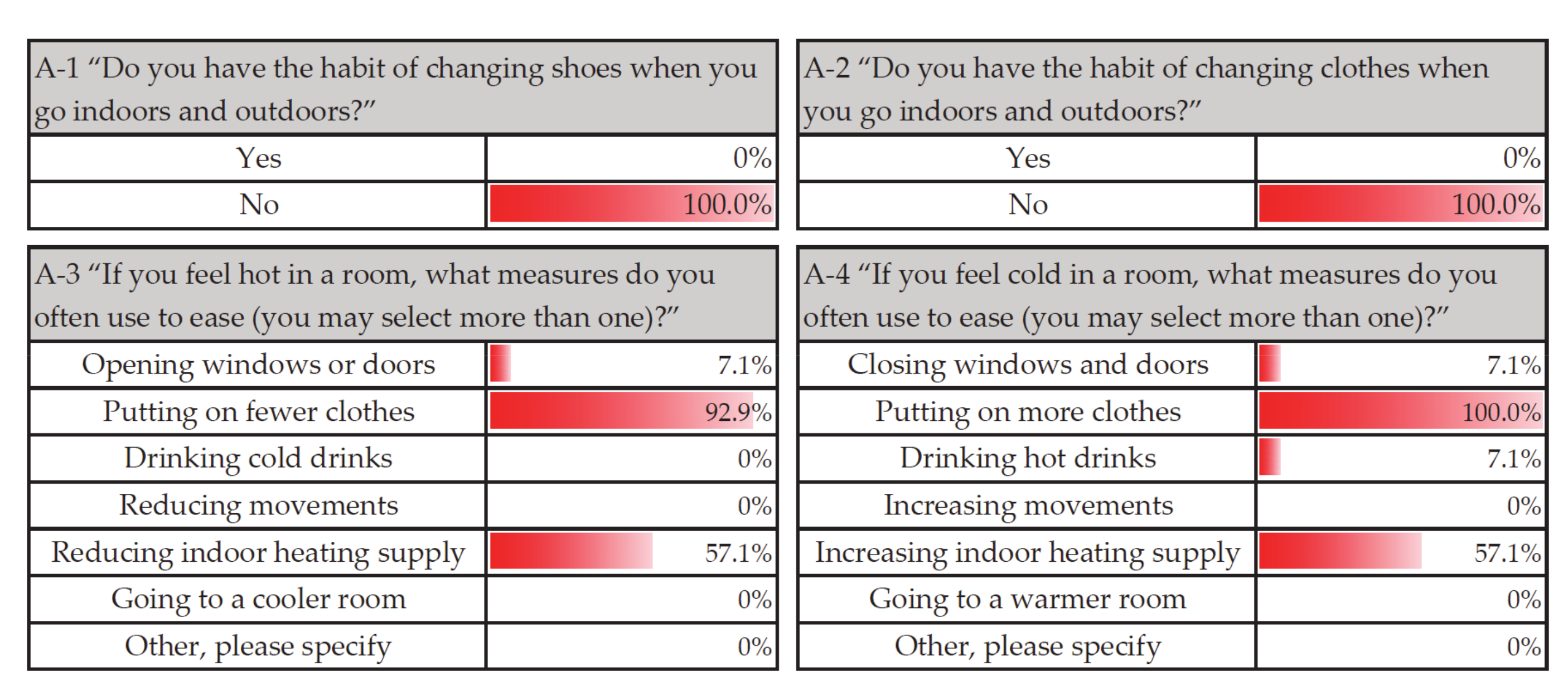

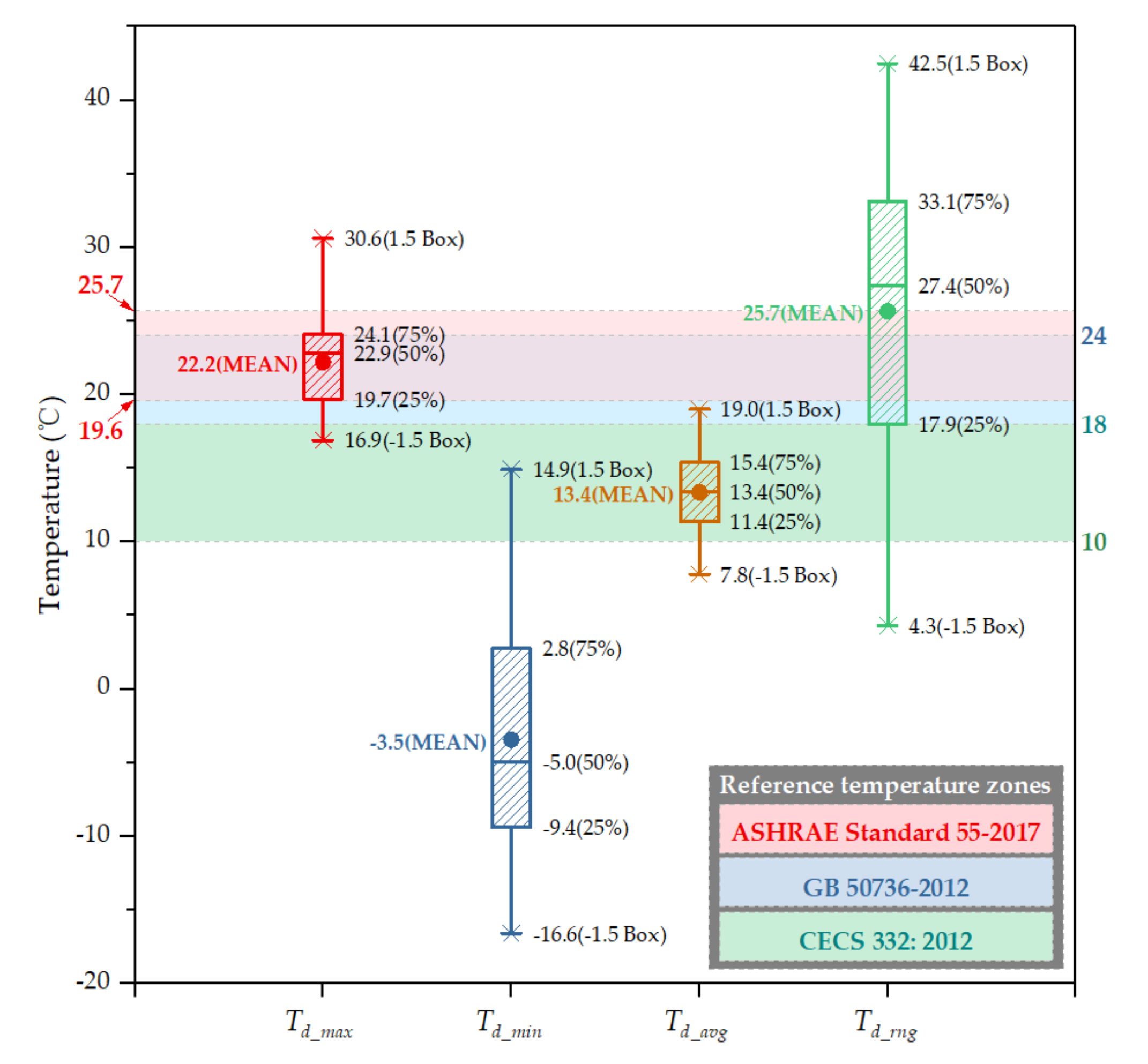

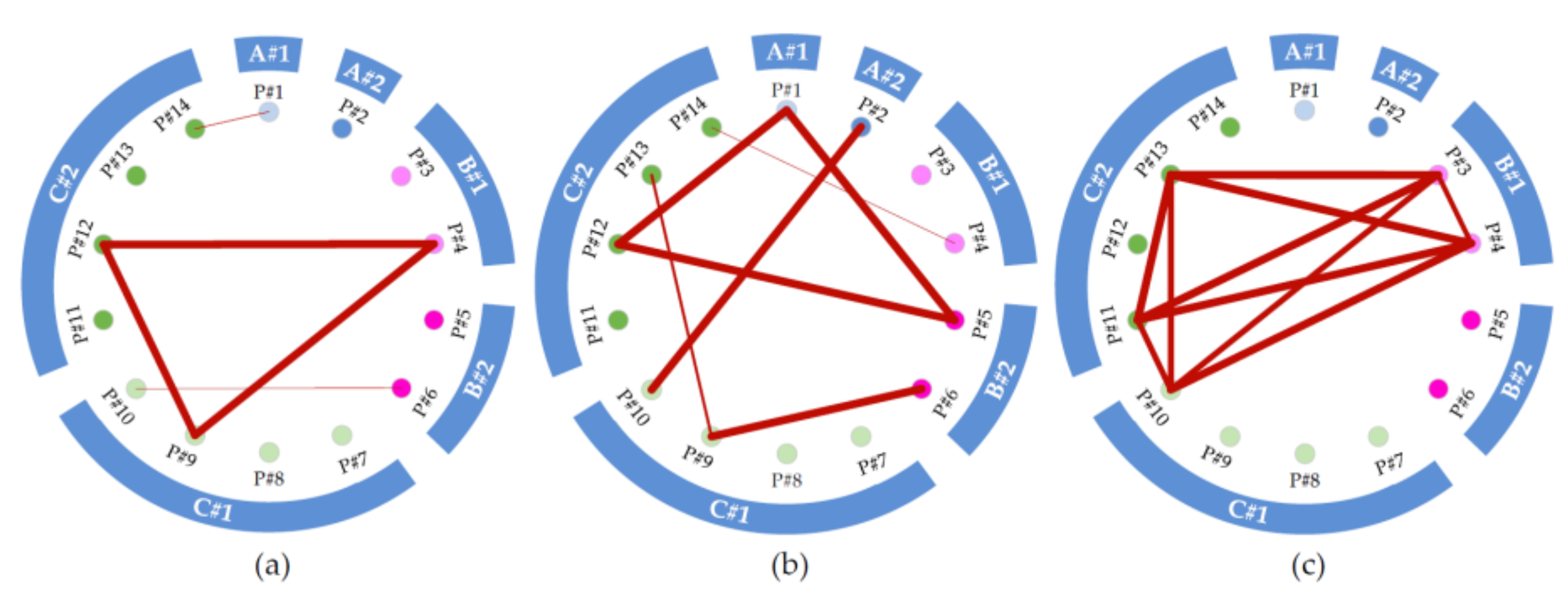
| Group | Household ID | Permanent Population | Permanent Residents’ ID | Gender | Age | Years of Living Locally |
|---|---|---|---|---|---|---|
| A | A#1 | 1 | P#1 | Female | 51 | 51 |
| A#2 | 1 | P#2 | Male | 80 | 80 | |
| B | B#1 | 2 | P#3 | Female | 47 | 47 |
| P#4 | Male | 49 | 49 | |||
| B#2 | 2 | P#5 | Female | 58 | 58 | |
| P#6 | Male | 61 | 61 | |||
| C | C#1 | 4 | P#7 | Female | 46 | 46 |
| P#8 | Female | 70 | 70 | |||
| P#9 | Male | 47 | 25 | |||
| P#10 | Male | 73 | 73 | |||
| C#2 | 4 | P#11 | Female | 51 | 51 | |
| P#12 | Female | 74 | 74 | |||
| P#13 | Male | 49 | 49 | |||
| P#14 | Male | 78 | 54 |
| Standard | PPD 1 (%) | PMV 2 Range | Indoor Temperature (°C) | Clothing Assumption (clo) |
|---|---|---|---|---|
| ASHRAE 3 55-2017 [52] | <10 | −0.5 < PMV < +0.5 | 19.6–25.7 | 1.0 |
| GB 4 50736-2012 [53] | ≤25 | −1 ≤ PMV ≤ 0 | 18–24 | 1.0 |
| CECS 5 332:2012 [54] | — | — | 10–18 6 | 1.2–2.0 7 |
| Questions | Answer Options | Selection Results | |
|---|---|---|---|
| 1st Survey | 2nd Survey | ||
| B-1 “Have you ever been to the outside since wearing the device or since our last visit?” | -Yes -No | 14 0 | 12 2 |
| B-2 “Have you changed your shoes when you go indoors and outdoors since wearing the device or since our last visit?” | -Yes, please specify -No | 0 14 | 0 14 |
| B-3 “Have you changed your clothes when you go indoors and outdoors since wearing the device or since our last visit?” | -Yes, please specify -No | 0 14 | 1 13 |
| B-4 “Do you have any trouble or feeling uncomfortable by wearing the device?” | -Yes, please specify -No | 0 14 | 0 14 |
| B-5 “Does wearing the device affect your normal movements or lifestyle?” | -Yes, please specify -No | 0 14 | 0 14 |
| B-6 “Have you deliberately changed your behavior because of wearing the device?” | -Yes, please specify -No | 0 14 | 0 14 |
| B-7 “According to your records, please indicate the (period of) time when you did not wear the device since the first time you put it on or since our last visit (you may select more than one option)?” | -Bedtime at night -Naptime in the afternoon -Other, please specify | 14 0 0 | 14 0 0 |
| Questions | Answer Options | Selection Results | |
|---|---|---|---|
| 1st Survey | 2nd Survey | ||
| C-1 “Have you ever felt uncomfortable with the air temperature since wearing the device or since our last visit?” | -Yes, please specify -No | 0 14 | 0 14 |
| C-2 “Have you experienced any unacceptable air temperature since wearing the device or since our last visit?” | -Yes, please specify -No | 0 14 | 0 14 |
| C-3 “Have you ever felt uncomfortable with the general thermal environment since wearing the device or since our last visit?” | -Yes, please specify -No | 0 14 | 0 14 |
| C-4 “Have you experienced any unacceptable thermal environment since wearing the device or since our last visit?” | -Yes, please specify -No | 0 14 | 0 14 |
| C-5 “In your opinion the thermal environment you have experienced since wearing the device or since our last visit is tolerable?” | -Yes -No | 14 0 | 14 0 |
| C-6 “Taking into account your personal preference only, would you accept rather than reject the thermal environment you have experienced since wearing the device or since our last visit?” | -Yes -No | 14 0 | 14 0 |
| C-7 “Are you generally satisfied with thermal environment you have experienced since wearing the device or since our last visit?” | -Yes -No | 14 0 | 14 0 |
| Permanent Residents’ ID | Distribution Type and Formula | μ | w | Adjusted R2 2 | ||
|---|---|---|---|---|---|---|
| Value | S.E.1 | Value | S.E. | |||
| P#1 | Distribution type: Gaussian distribution The specific formula described below was used for the fitting. where y0 is the baseline offset, μ is the mathematical expectation of the Gaussian distribution, w equals 2 times the standard deviation of the distribution or approximately 0.849 the width of the peak at half height, and A is the area under the peak of Gaussian distribution curve. | 16.01 | 0.05 | 1.77 | 0.10 | 0.93 |
| P#2 | 9.84 | 0.10 | 2.78 | 0.21 | 0.87 | |
| P#3 | 11.31 | 0.09 | 1.59 | 0.17 | 0.76 | |
| P#4 | 11.48 | 0.09 | 1.50 | 0.16 | 0.73 | |
| P#5 | 13.22 | 0.41 | 7.81 | 0.92 | 0.72 | |
| P#6 | 9.82 | 0.49 | 10.90 | 1.18 | 0.75 | |
| P#7 | 16.38 | 0.04 | 1.11 | 0.05 | 0.95 | |
| P#8 | 17.89 | 0.05 | 1.58 | 0.11 | 0.91 | |
| P#9 | 16.58 | 0.02 | 1.38 | 0.04 | 0.98 | |
| P#10 | 9.22 | 0.28 | 4.35 | 0.60 | 0.66 | |
| P#11 | 13.07 | 0.04 | 2.96 | 0.08 | 0.98 | |
| P#12 | 14.18 | 0.33 | 6.84 | 0.72 | 0.76 | |
| P#13 | 13.25 | 0.13 | 3.05 | 0.26 | 0.84 | |
| P#14 | 14.91 | 0.20 | 4.60 | 0.43 | 0.81 | |
© 2020 by the authors. Licensee MDPI, Basel, Switzerland. This article is an open access article distributed under the terms and conditions of the Creative Commons Attribution (CC BY) license (http://creativecommons.org/licenses/by/4.0/).
Share and Cite
Ma, R.; Fu, Y.; Deng, M.; Ding, X.; Baumgartner, J.; Shan, M.; Yang, X. Measurement of Personal Experienced Temperature Variations in Rural Households Using Wearable Monitors: A Pilot Study. Int. J. Environ. Res. Public Health 2020, 17, 6761. https://doi.org/10.3390/ijerph17186761
Ma R, Fu Y, Deng M, Ding X, Baumgartner J, Shan M, Yang X. Measurement of Personal Experienced Temperature Variations in Rural Households Using Wearable Monitors: A Pilot Study. International Journal of Environmental Research and Public Health. 2020; 17(18):6761. https://doi.org/10.3390/ijerph17186761
Chicago/Turabian StyleMa, Rongjiang, Yu Fu, Mengsi Deng, Xingli Ding, Jill Baumgartner, Ming Shan, and Xudong Yang. 2020. "Measurement of Personal Experienced Temperature Variations in Rural Households Using Wearable Monitors: A Pilot Study" International Journal of Environmental Research and Public Health 17, no. 18: 6761. https://doi.org/10.3390/ijerph17186761
APA StyleMa, R., Fu, Y., Deng, M., Ding, X., Baumgartner, J., Shan, M., & Yang, X. (2020). Measurement of Personal Experienced Temperature Variations in Rural Households Using Wearable Monitors: A Pilot Study. International Journal of Environmental Research and Public Health, 17(18), 6761. https://doi.org/10.3390/ijerph17186761





